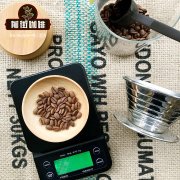History of the Origin and Development of Brazilian Coffee beans Flavor and taste characteristics of Brazilian Arabica coffee beans

Professional coffee knowledge exchange more coffee bean information please follow the coffee workshop (Wechat official account cafe_style)
When it comes to Brazilian coffee, Brazilian coffee generally refers to coffee produced in Brazil. There are many kinds of Brazilian coffee beans, the vast majority of which are unwashed and sun-dried, and are classified according to the name of the state of origin and the port of transport. Brazil has 21 states and 17 states.
Coffee tastes bitter, has a specific flavor, contains caffeine alcohol and 1, 3% caffeine alkaloids, and is an anesthetic, diuretic, excitatory and cardiotonic drug. Roasted coffee is also good for digestion.
Coffee beans contain caffeine, which can stimulate the central nervous system, promote the decomposition of liver glycogen and raise blood sugar. Moderate drinking can make people temporarily energetic and quick-thinking. Drinking after exercise has the effect of eliminating fatigue, restoring physical strength and invigorating spirit.
The History of Brazilian Coffee Story
The Brazilian coffee story began in the 1720s when Francesco Paletta, a Portuguese captain from Brazil who was introduced from French Guiana, captured the heart of the then governor's wife in Cayenne, the capital of French Guinea. successfully brought coffee seeds to Brazil. Since then, coffee has adapted rapidly in Brazil, spreading from the north to the southeastern state of Sao Paulo. By 1845, Brazilian coffee beans accounted for 45% of the world's coffee beans and became the main source of income in the state of Sao Paulo.
With the development of coffee, Brazilian coffee is also very important in the world. Brazilian coffee beans provide nearly 45% of the world's coffee raw beans. The length of the country's dry season may even affect coffee prices around the world.
Before 1990, the Brazilian government carried out strict monitoring of the coffee industry, with both strict intervention and price protection measures, and the state has been implementing a minimum price protection policy for farmers, resulting in coffee overproduction. By the beginning of the 21 century, due to the lack of global regulation, world coffee production was much higher than consumption, and the country hardest hit was the giant Brazil. The collapse of the European coffee market in 1940 almost destroyed Brazil's coffee industry, and the United States realized that if the Brazilian economy collapsed and the pro-American government collapsed, Brazil would fall to the fascist regime. So Brazil decisively bought all the unsold coffee beans from 1941 to 1943 to solve the crisis, and Brazil finally got by.
Finally, under the pressure of the global coffee crisis, the World Coffee Agreement was born. This agreement, signed by more than 60 countries that produce and consume coffee, limits the number of coffee imports and exports of producing and consuming countries through the quota system, stabilizes coffee prices, and finally ushered in the longest stable period for dozens of coffee producing countries, including Brazil. However, the good times did not last long. Brazil announced its withdrawal from the World Coffee Agreement in 1989, when the Cold War ended. The coffee crisis is still the culprit leading to the poverty and backwardness of most of the world's coffee-producing countries.
Brazilian coffee beans are characterized by mellow taste and rich flavor of nut chocolate.
Important Notice :
前街咖啡 FrontStreet Coffee has moved to new addredd:
FrontStreet Coffee Address: 315,Donghua East Road,GuangZhou
Tel:020 38364473
- Prev

Introduction to Blue Mountain Coffee beans: how to Bake Blue Mountain Coffee beans? what is the good baking degree?
Professional coffee knowledge exchange more coffee bean information please follow the coffee workshop (Wechat official account cafe_style)
- Next

Guide to the baking curve of Jamaica Blue Mountain Coffee description of taste and flavor of different treatments of Blue Mountain Coffee
Professional coffee knowledge exchange more coffee bean information please follow the coffee workshop (Wechat official account cafe_style)
Related
- Detailed explanation of Jadeite planting Land in Panamanian Jadeite Manor introduction to the grading system of Jadeite competitive bidding, Red bid, Green bid and Rose Summer
- Story of Coffee planting in Brenka region of Costa Rica Stonehenge Manor anaerobic heavy honey treatment of flavor mouth
- What's on the barrel of Blue Mountain Coffee beans?
- Can American coffee also pull flowers? How to use hot American style to pull out a good-looking pattern?
- Can you make a cold extract with coffee beans? What is the right proportion for cold-extracted coffee formula?
- Indonesian PWN Gold Mandrine Coffee Origin Features Flavor How to Chong? Mandolin coffee is American.
- A brief introduction to the flavor characteristics of Brazilian yellow bourbon coffee beans
- What is the effect of different water quality on the flavor of cold-extracted coffee? What kind of water is best for brewing coffee?
- Why do you think of Rose Summer whenever you mention Panamanian coffee?
- Introduction to the characteristics of authentic blue mountain coffee bean producing areas? What is the CIB Coffee Authority in Jamaica?

